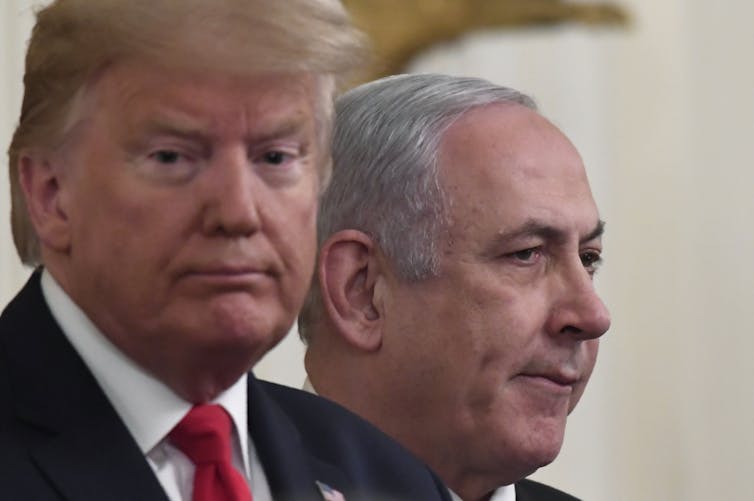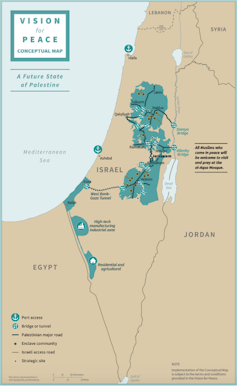Has Trump proposed a Middle East peace plan – or terms of surrender for the Palestinians?

Susan Walsh/AP Photo
Yehudah Mirsky, Brandeis University
January 28, 2020, is a date that will be remembered in Middle Eastern history – but it will take some time before anyone knows for sure how it will be remembered.
The day didn’t start well for Benjamin Netanyahu. Israel’s longest-serving prime minister also became the country’s first prime minister to be indicted while still in office. He faces multiple charges of corruption.
But Netanyahu didn’t have much time to sulk. Just a few hours later, he was standing alongside Donald Trump as the pair unveiled the U.S. administration’s long-anticipated plan for Israeli-Palestinian peace, written in no small part in coordination with – and deeply in tune with – Netanyahu’s policies.
The fact that the plan’s unveiling came as both men face intense domestic scrutiny – the press conference interrupted coverage of Trump’s impeachment – should not be overlooked.
I have been following developments in the Middle East for a long time as a U.S. State Department official, a lifelong student and now a professor of Israeli history, and as a dual citizen of the U.S. and Israel. I know how complex the issues are and how past attempts at peace have fallen well short.
In black and white …
Trump’s plan comprises two different goals.
The first – fostering Israeli-Palestinian peace, or at least coexistence – is there in black and white for all to read.
The second – tying Trump and Netanyahu’s respective domestic critics into knots – is everywhere between the lines.
While the Trump administration worked on the plan in coordination with Israel and “friendly” Arab states like Egypt and Saudi Arabia, it crucially did not involve the Palestinians. Palestinian resistance to the very development of this plan – out of suspicion, weakness and resentment – was met not with a carrot but a stick, with the U.S. cutting all aid to Gaza and the West Bank in February 2019.
As a result, positions in the plan that might have been viewed as difficult compromises, had they been negotiated, are instead rightly seen as terms of surrender. Yes, the plan gives Palestinians a path to limited statehood, but only after ceding on the core issues of Israeli settlements, refugees and control of much of Jerusalem.
The plan was successfully kept behind the curtains while being drafted, but it now steps out onto a complicated stage.
Relations between Israel and the Palestinian Authority in the West Bank have for some years been in utter political stalemate, even as the two have maintained working-level security cooperation. In Hamas-run Gaza, Israel has been in a long war of attrition, mixing ongoing less-than-total violence with tacit mutual understandings aimed at managing the conflict.
Meanwhile, Israel’s ties with several Sunni Arab states, especially in the Gulf, have been deepening, united by a desire to ward off Iran and its Shia proxies in Lebanon and what remains of Syria. Jordan, structurally weak but strategically important due to its location and links to Arab and Islamic actors, balances contending forces with skill and jitters.
Internal Palestinian politics are riven by the bitter rivalry between the nationalist Palestinian Authority and the Islamist group Hamas and by discontent with the Palestinian Authority’s President Mahmoud Abbas’ hold on power amid claims of corruption and mismanagement in the Palestinian semi-government.
Israeli politics is stalemated, too, and headed for its third round of parliamentary elections in less than a year, spurred by fallout from Netanyahu’s corruption scandals and a fragmented opposition.
Many Israelis are alienated by Netanyahu’s endless legal troubles and divisive politics, but others are kindled by his attacks on political opponents. Meanwhile the Israeli left has failed to recover the credibility it lost on security issues following the collapse of 2000’s Camp David talks and the ensuing Second Intifada.
As for Trump, he remains popular in Israel – including among centrists, who don’t necessarily follow day-to-day U.S. politics and look unfavorably on former President Barack Obama’s handling of the Middle East.
At home, Trump’s policies on Israel do not reflect that of the majority of American Jews, who tend to be politically liberal and supportive of a mutually negotiated two-state solution. Rather, Trump’s views chime with that of the smaller but more fervent American Jewish right, and above all with the millions of evangelicals who are a key plank of the president’s base.
Into all this drops the 180-page peace plan – whose heart is creating a legally recognized but geographically tiny and fragmented Palestinian state without full military powers – something that falls way short of Palestinian aspirations. Some parts of the plan are not unreasonable, and the many failed attempts at peacemaking to date call for fresh thinking. But the problems in this plan are very real.
It stakes out strong positions on the three hard issues that have bedeviled negotiations time and again: Israeli settlements, the status of Jerusalem and the right of return for Palestinian refugees.
The Trump plan leaves all Israeli settlements in place and proposes a networks of roads and tunnels to help Palestinian move around the cantons that would make up their state.

The White House
It also freezes Jerusalem’s status quo and makes permanent Israel’s security barrier between the city’s east and west. As for the Palestinians who fled or were forced out of their homes in the 1948 war and their descendants, the plan says they are to be financially compensated. A few will be absorbed into Israel, but most will be integrated into either the envisioned Palestinian state or their current country of residence – which includes the Arab states that have refused to absorb them to date.
These stances will be politically helpful to Netanyahu and congenial to many Israelis, who want to end the country’s occupation of the Palestinians, if their own personal security can be assured.
To the Palestinians, they represent bitter pills, each of which would be hard enough to swallow on its own.
Reaction to the plan has led to talk of a possible reconciliation between the Palestinian Authority and Hamas, something Israel has been trying to avoid – and put security forces on alert for further violence.
Another problem is in the thinking that is evident in the plan’s title, “Peace to Prosperity.” Blueprints for economic development are woven throughout. The ideas are laudable. But the notion that the most fervently committed Jews and Arabs will trade away their deepest convictions for financial gain is as unlikely to take hold now as it did in the Oslo Accords of the 1990s.
… and red lines all over
So what happens now?
Netanyahu has announced he will begin to annex territory, in a move his main political challenger, former Army Chief of Staff Benny Gantz, described as “reckless and irresponsible,” even as he says he accepts the plan’s broad outlines for an eventual settlement. The Palestinians for their part have rejected the proposals and taken to the streets in protest.
The plan raises some serious, immediate questions: How much unilateral action will Netanyahu take without paying a domestic price – especially with Israelis returning to the polls in March? And what responses are open to the Palestinians, other than the tried-and-failed turns to violence and appeals to the U.N. – neither of which will move Israeli public opinion in their direction?
Above all, the questions we should be asking are: What does this or any plan do concretely to improve the lives of people in the region? What practical steps could be taken to make viable coexistence – peace is too strong a word – further down the line possible or at least avert new violence triggered by thwarted expectations?
There is no easy solution to the bitter Israel-Palestinian conflict. Unilateral annexation by Israel will only further Palestinian resentment and rejectionism. Too many people, in Washington as well as the Middle East, view the conflict in terms of ideological dreams and agendas, paying little heed to the real needs of people on the ground, Israeli and Palestinian alike. Should this plan become, like so many of its predecessors, a political football on both sides of the ocean, the people who make their homes and live their lives on politicians’ playing fields will lose.
[ Insight, in your inbox each day. You can get it with The Conversation’s email newsletter. ]![]()
Yehudah Mirsky, Professor of Near Eastern and Judaic Studies, Brandeis University
This article is republished from The Conversation under a Creative Commons license. Read the original article.









